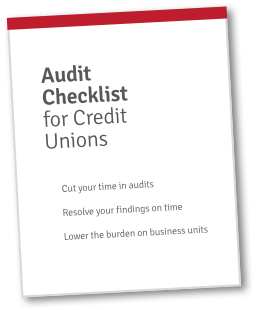We’re happy to announce the release of Redboard 10, the most comprehensive version of our audit management software platform yet. We’ve added new features and abilities that ensure smoother, more efficient credit union audits and exams.
When we debuted Redboard, it was a secure project management platform designed to help credit union compliance teams manage and navigate their annual regulatory exams. However, after incorporating client feedback, the platform is much more flexible and robust than ever.
Banking has been around for millennia, which shows just how important it is to the world. However, modern banking in our collected world brings new risks and threats. Financial institutions must operate responsibly to see that consumers thrive—and criminals don’t.
Rules and regulations keep everyone safe. But they also keep institutions busy. Credit unions in particular are familiar with the regulatory burden. Their compliance professionals and audit teams ensure smooth and stable operations.
But there are many regulations, and they have teeth. That’s why we’ve identified 10 easy credit union compliance tips to help even the most stressed-out audit teams.
Credit unions offer numerous advantages over banks and other financial institutions. Their services, fees, and rates are all top notch. And a good deal of that can be attributed to relatively strict rules and regulations regarding consumer safety.
However, they can get bogged down in those rules and regulations. The regulatory burden is heavy, and credit union compliance professionals have their hands full keeping up with changes to laws, practices, and guidelines.
Fortunately, the NCUA sends out a letter to credit unions every January. Each year, they detail their supervisory priorities for the coming year as well as any notable statutory and regulatory updates.
These are the statutory and regulatory updates for credit unions in 2020.
The world of credit union compliance is both fast-paced and high-stakes. It would be enough to drive any compliance professional mad… if there weren’t ample resources on their side.
Fortunately, the NCUA is also chock-full of compliance experts. And as such, they provide ample notice, explanation, and documentation for their regulatory moves.
Recently, the NCUA released its annual letter to credit unions. In that letter are a list of supervisory priorities for 2020. In case you haven’t seen the list yet, here’s a quick overview.
In 2019, Boeing faced the fallout of several 737 MAX airplane crashes. As the casualties rose, engineers and regulators raced to discover what was causing the flight malfunctions.
The answer was negligence of risk management across the organization. Here’s a very brief overview of what went wrong—and how following the three lines of defense would have helped.
Recently, we’ve been thinking about audits and examinations. We know, we know, that’s pretty par for the course over here. But we’ve been thinking about the exact role they take in the risk reduction process. Specifically, we’ve been thinking about the three lines of defense in audits.
We’ve got a couple blogs lined up to explore the topic. They’ll include non-financial industry comparisons and key takeaways for the credit union audit process.
So, let’s lay some groundwork.
At its core, Redboard is an automated exam and audit management tool for credit unions. But secrets don’t keep well among credit union departments. People outside of audit teams saw how Redboard worked and wanted to try it out.
Now, we’ve heard of several non-audit uses for Redboard at this point. We’re thrilled to see other departments benefiting from our software, and we figured we’d share these uses with you.
When we first started working on Redboard’s automation audit tools for credit unions, we had a few things in mind. For example, we wanted it to be robust, secure, time-saving, and easy to use.
We didn’t understand at the time just how important that last consideration truly was.
There’s no such thing as an all-knowing audit professional. There are too many rules and regulations in the credit union industry for a single person to know them all. It takes a team of experts to carry out an audit or examination in any given area.
So naturally, it takes that same level of teamwork to build our credit union audit software. Let us introduce you to how we set our product direction.
Remember way, way back in the old days at school? And how sometimes, for whatever reason, you’d get distracted for a couple seconds. And that’s when it always happened. The teacher called on you.
Are you supposed to act like you know what’s going on? Do you own up to it? Do you just blurt out random words and hope for the best until someone stops you?
It’s a terrible feeling. And we’re all happy to be done with school. But that doesn’t mean we’re safe from getting called on when we’re not ready. Credit union exams and audits can still approximate that feeling.
Let’s look at how to fix that.











 Get FREE Access to the Audit Checklist for Credit Unions!
Get FREE Access to the Audit Checklist for Credit Unions!


